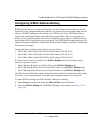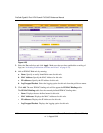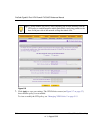
ProSafe Gigabit 8 Port VPN Firewall FVS318G Reference Manual
Firewall Protection and Content Filtering 4-41
v1.1, August 2010
3. Configure the following fields:
– Advertisement Period. Enter the period in minutes that specified how often the VPN
firewall should broadcast its UPnP information to all devices within its range.
– Advertisement Time to Live. Enter a number that specifies how many steps (hops) each
UPnP packet is allowed to propagate before being discarded. Small values will limit the
UPnP broadcast range.
4. Click Apply to save your settings.
The UPnP Portmap Table shows the IP addresses and other settings of UPnP devices that
have accessed the VPN firewall.
– Active. A Yes or No indicates if the UPnP device port that established a connection is
currently active.
– Protocol. Indicates the network protocol such as HTTP or FTP that is used by the device
to connect to the VPN firewall.
– Int. Port. Indicates if any internal ports are opened by the UPnP device.
– Ext. Port. Indicates if any external ports are opened by the UPnP device.
– IP Address. Lists the IP address of the UPnP device accessing the VPN firewall.
To refresh the contents of the UPnP Portmap Table, click refresh.
Email Notifications of Event Logs and Alerts
The firewall logs can be configured to log and then email denial of access, general attack
information, and other information to a specified email address. For example, your VPN firewall
will log security-related events such as: accepted and dropped packets on different segments of
your LAN; denied incoming and outgoing service requests; hacker probes and login attempts; and
other general information based on the settings that you enter on the Firewall Logs & E-mail
screen. In addition, if you have set up content filtering on the Block Sites screen (see “Blocking
Internet Sites (Content Filtering)” on page 4-30), a log will be generated when someone on your
network tries to access a blocked site.
To configure email or syslog notification, or to view the logs, see “Activating Notification of
Events and Alerts” on page 6-23.


















